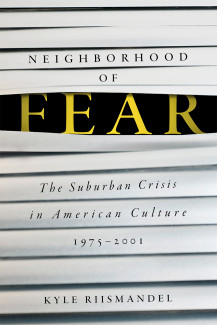
Johns Hopkins UniversityEst. 1876
America’s First Research University
Now Browsing:
Neighborhood of Fear: The Suburban Crisis in American Culture

One essential thing I learned while writing Neighborhood of Fear was so much of what I studied related directly to contemporary American culture including the roots of so many practices and beliefs prevalent today – from consumer-centered environmentalism and medicine to the continued focus on cultural products as the cause of social ills. Perhaps the most visible has been how suburban crime culture of the late twentieth century shaped perceptions of suburban streets and homes as criminally hazardous and homeowner rights to defend them as expansive. The continued expansion of private home security strategies and apparatuses are a logical outgrowth of suburban security culture that operates under the notion of constant threat.
Products like the Amazon-owned Ring smart doorbell continue to produce this suburban sensibility where homeowners feel both reassured and endangered by using new security technologies. It allows a homeowner to surveil their front door, speak to visitors, and generally mind their home even when not there all under the supposition that something could (or likely will) go wrong.
As Ring commercials demonstrate, its sales are premised on the same fears harbored by 1980s and 90s suburbanites. In an advertisement from 2015, Ring’s inventor Jamie Siminoff, explains that most burglaries are perpetrated during the day as the viewer watches a white man in a hoodie approach a house. The prowler attempts to ascertain if someone is home before he breaks in in broad daylight, presumably because the homeowner did not have a Ring camera. In a recent commercial, “Casual Crimefighter,” a homeowner at a basketball game uses Ring to see and scare away thieves breaking into his car. Hewing closely to the themes and imagery of 1990s ADT home security commercials, these ads reinforce and exploit the notion of invisible, lurking burglars waiting to strike in the suburbs that first emerged in the late 1970s.[1]

Like other internet-connected devices, Ring is connected to an app, Nextdoor. It and its competitors Citizen and Neighbor expand and enhance suburban paranoia as homeowners share information about strange characters, unfamiliar vehicles, and shifty deliverymen. As in the late twentieth century, homeowners today are using these powerful security tools to protect homes and families. Yet, their use is more likely to sow fear and skepticism of strangers, outsiders, or anyone who appears out of place, even as crime rates continue to fall.[2] Indeed, widespread fear has led police and neighbors to accuse parents of neglect for letting their children walk to school alone or play without supervision in public space because those places are seen as inherently dangerous.
In this way, suburban crime culture continues to facilitate and be facilitated by “tough on crime” culture and politics that produced disproportionate outcomes for people of color as seen in the new Jim Crow and the “golden gulag.”[3] Since the late 1960s, progressively militarized urban policing practices increasingly scrutinize populations of color subjecting them to strict regimes of surveillance and incarceration while suburbanites work with law enforcement and choose to monitor themselves.[4] Today, this disparity can be seen as Ring has partnered with dozens of police departments to work with homeowners in installing the devices to prevent home invasions and assist police in catching invaders.[5]
The ramifications of suburban crime culture can most clearly be seen in the incidents of homeowner violence committed against supposedly threatening individuals in their suburban communities, almost always young people of color. The emergence of suburban streets and homes as endangered led to the expansion of the Castle Doctrine and its public space extension in Stand Your Ground laws. What followed were hundreds of other shootings supposedly justified by Stand Your Ground laws including George Zimmerman’s murder of Trayvon Martin in his gated community and Gregory McMichael and Travis McMichael stalking and killing Ahmaud Arbery in Satilla Shores, Georgia. The homeowner’s nearly unmitigated right to use violence in this way exists because of the suburban crime culture forged over the previous forty-five years, as detailed in chapter 3 of Neighborhood of Fear.
All of these examples, then, demonstrate a now dominant coding of suburban space as inherently dangerous, requiring vigilant surveillance, and even in need of the dispensation of private justice.
This passage has been adapted from the Epilogue (pages 180-181) of Neighborhood of Fear.
Order Neighborhood of Fear: The Suburban Crisis in American Culture, 1975–2001 at the following link: https://jhupbooks.press.jhu.edu/title/neighborhood-fear
Kyle Riismandel is a senior lecturer in the Federated Department of History at the New Jersey Institute of Technology. He is the author of Neighborhood of Fear: The Suburban Crisis in American Culture, 1975–2001.
References:

Products like the Amazon-owned Ring smart doorbell continue to produce this suburban sensibility where homeowners feel both reassured and endangered by using new security technologies. It allows a homeowner to surveil their front door, speak to visitors, and generally mind their home even when not there all under the supposition that something could (or likely will) go wrong.
As Ring commercials demonstrate, its sales are premised on the same fears harbored by 1980s and 90s suburbanites. In an advertisement from 2015, Ring’s inventor Jamie Siminoff, explains that most burglaries are perpetrated during the day as the viewer watches a white man in a hoodie approach a house. The prowler attempts to ascertain if someone is home before he breaks in in broad daylight, presumably because the homeowner did not have a Ring camera. In a recent commercial, “Casual Crimefighter,” a homeowner at a basketball game uses Ring to see and scare away thieves breaking into his car. Hewing closely to the themes and imagery of 1990s ADT home security commercials, these ads reinforce and exploit the notion of invisible, lurking burglars waiting to strike in the suburbs that first emerged in the late 1970s.[1]

Like other internet-connected devices, Ring is connected to an app, Nextdoor. It and its competitors Citizen and Neighbor expand and enhance suburban paranoia as homeowners share information about strange characters, unfamiliar vehicles, and shifty deliverymen. As in the late twentieth century, homeowners today are using these powerful security tools to protect homes and families. Yet, their use is more likely to sow fear and skepticism of strangers, outsiders, or anyone who appears out of place, even as crime rates continue to fall.[2] Indeed, widespread fear has led police and neighbors to accuse parents of neglect for letting their children walk to school alone or play without supervision in public space because those places are seen as inherently dangerous.
In this way, suburban crime culture continues to facilitate and be facilitated by “tough on crime” culture and politics that produced disproportionate outcomes for people of color as seen in the new Jim Crow and the “golden gulag.”[3] Since the late 1960s, progressively militarized urban policing practices increasingly scrutinize populations of color subjecting them to strict regimes of surveillance and incarceration while suburbanites work with law enforcement and choose to monitor themselves.[4] Today, this disparity can be seen as Ring has partnered with dozens of police departments to work with homeowners in installing the devices to prevent home invasions and assist police in catching invaders.[5]
The ramifications of suburban crime culture can most clearly be seen in the incidents of homeowner violence committed against supposedly threatening individuals in their suburban communities, almost always young people of color. The emergence of suburban streets and homes as endangered led to the expansion of the Castle Doctrine and its public space extension in Stand Your Ground laws. What followed were hundreds of other shootings supposedly justified by Stand Your Ground laws including George Zimmerman’s murder of Trayvon Martin in his gated community and Gregory McMichael and Travis McMichael stalking and killing Ahmaud Arbery in Satilla Shores, Georgia. The homeowner’s nearly unmitigated right to use violence in this way exists because of the suburban crime culture forged over the previous forty-five years, as detailed in chapter 3 of Neighborhood of Fear.
All of these examples, then, demonstrate a now dominant coding of suburban space as inherently dangerous, requiring vigilant surveillance, and even in need of the dispensation of private justice.
This passage has been adapted from the Epilogue (pages 180-181) of Neighborhood of Fear.
Order Neighborhood of Fear: The Suburban Crisis in American Culture, 1975–2001 at the following link: https://jhupbooks.press.jhu.edu/title/neighborhood-fear
Kyle Riismandel is a senior lecturer in the Federated Department of History at the New Jersey Institute of Technology. He is the author of Neighborhood of Fear: The Suburban Crisis in American Culture, 1975–2001.
References:
- This is a youtube playlist for the book that includes these ADT commercials - https://www.youtube.com/playlist?list=PLwxeKweQuAmDmyr94JtLBV4XZRvL7f-7t
- Rani Molla, “The Rise of Fear-Based Social Media like Nextdoor, Citizen, and now Amazon’s Neighbors,” Vox, May 7, 2019; Michael Harriot, “App Developer Responds to ‘The Racist Nextdoor,’<TH>” The Root, July 1, 2019.
- Alexander, The New Jim Crow, 1–19; Gilmore, Golden Gulag, 5–30.
- Davis, City of Quartz, 253–57.
- Paresh Dave, “Ring Modernized the Doorbell, Then Its Inventor, Jamie Siminoff, Went to War Against Crime,” Los Angeles Times, May 12, 2017.

Login to View & Leave Comments
Login to View & Leave Comments


